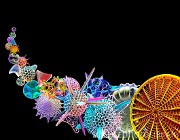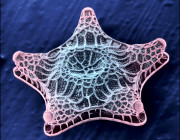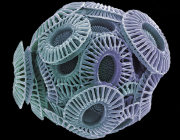Home :: List of Publicly Available Datasets :: Lingulodinium polyedra CCMP 1738
Lingulodinium polyedra CCMP 1738
Downloads:
| Principle Investigator(s) | Mary Ann Moran |
|---|---|
| External sample ID | 1738 dark 24 hrs extended |
| NCGR Sample ID | MMETSP1035 |
| Sample accession number | CAM_SMPL_002589 |
| Assembly accession number | CAM_ASM_000407 |
| Combined Assembly Name | Lingulodinium-polyedra-CCMP1738 |
| Genus | Lingulodinium |
| Species | polyedra |
| Strain | CCMP 1738 |
| Clonal | Yes |
| Axenic | No |
| Prelim. NCBI Taxon ID | 160621 |
| 18S rRNA | |
| Importance of organism and transcriptomes | Dinoflagellates and bacteria are intimately associated in the marine environment, and many bacteria can break down phytoplankton-derived dimethylsulfonium compounds, like DMSP. L. polyedra also produces some of the lesser known dimethylsulfonium derivatives, including gonyauline and/or gonyol. We are interested in how the production of these compounds as well as the interaction between dinoflagellates and bacteria vary under different conditions (i.e. light versus dark). This work will also provide insight into multi-derivative-dimethylsulfonium-producing dinoflagellates (i.e., those that produce sulfonium compounds other than DMSP) and the fate of these compounds in the oceans and atmosphere. |
| Additional citations and references | Tanikawa, N., H. Akimoto, K. Ogoh, W. Chun, and Y. Ohmiya. 2004. Expressed sequence tag analysis of the dinoflagellate Lingulodinium polyedrum during dark phase. Photochem Photobiol 80:31-5. Mayali, X., P. J. Franks, and F. Azam. 2008. Cultivation and ecosystem role of a marine Roseobacter clade-affiliated cluster bacterium. Appl. Environ. Microbiol. 74:2595-603 |
| Environmental Data | |
| Latitude | 27.8 |
| Longitude | 97.13 |
| Sample collection site | Gulf of Mexico |
| Other collection site info | Texas Coast |
| ENVO term for habitat - primary term | Acquatic: marine |
| ENVO term for habitat - secondary term | Not Applicable |
| Habitat description | Gulf of Mexico off the coast of Texas |
| Habitat | marine habitat |
| Country | UNITED STATES |
| Experimental Data | |
| Date of experiment | 09-SEP-11 |
| Growth medium | f/2 - Si artificial seawater |
| Modifications to growth medium | f/2 for all nutrients, minus the addition of Si |
| Temperature (ºC) | 18 |
| Salinty (psu) | 28 |
| pH | 8.3 |
| Light (µmol photons / m2 / sec) | 150 |
| Day portion of day:night cycle in hours | 12 |
| Night portion of day:night cycle in hours | 12 |
| Nitrate (μmol/L) | 882 |
| Phosphate (μmol/L) | 36.2 |
| Trace elements (total) (nmol/L) | 24500 |
| Investigation type | Eukaryotes |
| Other experimental metadata available | Chlorophyll, DMSPt, DMSPd, and DMSPp will be measured. Dimethylsulfonium derivatives will also be analyzed. |








